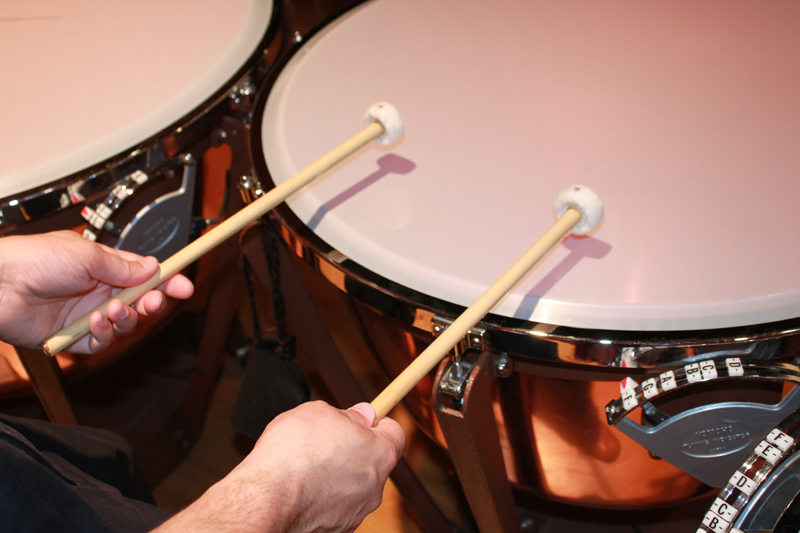Vowels, vowels, vowels. Choir directors are all about vowels. Vowels are all about shape. The biggest problem I encounter with vowels is that they lack height. Another problem is that they lack structure. Here are some tips to help both problems.
AW-ROO – your new best friend. AW-ROO came to me from Jean Barford, a champion Sweet Adeline barbershop singer/director. Just slowly say “AW-ROO.” You should feel as if you are making the shape of a cheerleader’s megaphone, only facing backwards. The larger end (AW) is in the back of your throat. The smaller end (ROO) is in the front with your lips. The theory behind AW-ROO is that all vowels are inside that megaphone/cone. Larger vowels (EH, AW, AH, OH) are in the AW space and smaller vowels (EE, IH, OO) are funneled through the ROO space. AW-ROO is tall and round – just what we want! Just saying AW-ROO can remind your choir to guard against “spreading” their vowels. Anything outside that cone is forbidden!
VOWEL BLOSSOM – This is my code for when singers take an especially long time to open their mouths from a closed consonant to a target vowel, thus creating a sound like an old record player getting up to speed. Say the word “swatch” in slow motion and you’ll feel a vowel blossom. These often occur when singers are attempting a crescendo. They increase space and volume at the same time, rather than forming a firm, structured vowel and increasing the volume independently. The first step to eliminating vowel blossoms is to acknowledge their existence. The next step is…
INSTABANG – another barbershop gem, and the cure for vowel blossoms. It refers to the process of getting quickly from the formation of a consonant back to a large, open, pure vowel formation. BANG! Snap that vowel open in an instant: INSTABANG, as in, “Come on, choir – instabang those vowels!” (Notes: this was coined before Instagram, but that can’t hurt for tying this concept in with young singers. If you are afraid of any giggles, you could also change the word to INSTAPOP.)
Polluted Vowels
I have noticed that my choirs often sing less-than-pure vowels when the end of the syllable/word contains a singable consonant. R’s, L’s, and N’s are especially troublesome. I call these polluted vowels. Vowels can also be polluted when anticipating the second half of a diphthong.
Imagine you have a bottle of drinking water. Now add just a bit of ink. It isn’t like you dropped a dime into the bottle, where you can see it shouldn’t be there but can drink the water anyway. The ink has polluted the water throughout, turning what was once clear into a murky grey. That’s what singable consonants/diphthongs can do to a vowel – tainting the purity to our ears.
My men’s chorus is singing “Laudamus,” a Welsh hymn, done in English. Many phrases end with the word “evermore.” When they hold the last note, I can so clearly hear the R polluting the OH vowel.
Just say the word “more” in slow motion. You’ll feel the point at which the OH has been compromised, but it comes before you are sustaining a pure R. Try the word “bound,” and notice the collapsed point between the AW and OOH of the diphthong. These are polluted vowels, and choirs sing them all the time because they cling their speaking constructs of the language.
Fear not-I have a solution! It’s called word switching. Let’s try it on this MORE scenario. I had my men sing and hold the chord on MORE. It was polluted. I explained the concept of polluted vowels and asked them to only sing a pure MOH with no R. Didn’t work. Then I asked them to sing the word MOTION, which does not have a singable consonant following the MOH. “Sing MO-TION but hold the MOH until I cue you to go on to TION.” BOOM! A crystal clear OH vowel!
It works for dipthongs, too. Having trouble with BOUND? Hold the first half of BOSTON. MAKE? Try MEXICO. LIGHT? Try LOBSTER. Get the pattern?
By changing the English word, we are using our singers’ tendencies against them. It’s a simple trick that can be used in the short term until singing the correct pure vowel becomes a long-term habit. Listen in your next rehearsal and clean up those vowels. No one likes pollution.
The Wall of Sound
A problem I face in rehearsal is that of muddy ensemble sound. This is most commonly noticed in homophonic passages, where the chords don’t ring as clearly as I want. Poor synchronization of word sounds is often the culprit. I use this process (borrowed from barbershoppers) to clean up the vocal lines. It’s called The Wall of Sound, because it creates a strong, uninterrupted sound from the choir. Vowels are bricks and consonants the mortar. In a strong wall there must be much more brick than mortar; the mortar must completely connect the bricks.
Step 1 – Model in unison: Sing the passage on one mid-range note that is accessible to the choir (in octaves for mixed choirs). Sing it as you wish to hear it. Have the choir then sing it back to you on that unison note. Listen carefully for the treatments of consonants and vowels, including diphthong turns. Make sure the choir is following your timing in all ways, and that the pitch doesn’t bend or scoop at all. Make them tunnel forward with a constant stream of sound. The goal is to become one voice. If needed, slow the tempo down to hear the timing of word sounds, then gradually speed up until you hit performance tempo.
Step 2 – Spread to a chord: After the word sounds are synchronized across the choir in unison, assign each section a note in a chord in the key of that section. Example: F major-basses/F, tenors/middle C, altos/F, sopranos/A. Sing the passage on this static chord, working synchronization as you did in the unison. The goal is to create a constant, ringing sound where vowels are matched, singable consonants ring with true pitch, and plosives click together. Again, vary the tempo as needed to make sure everyone is moving together cleanly. If this is too ambitious, start with the cleanest section, then add others one at a time for quality control.
Step 3 – Resume parts: Have sections sing their original notes but in the new style of the static chord. The goal is to now hear The Wall of Sound. Variation of tempo is valuable in this stage, to ensure everyone’s word sounds are synchronized.







 More than a dozen middle and elementary school students beat out the rhythmic tunes of Zimbabwe-inspired ballads and popular Christmas songs at the Festival of Trees at Valley River Inn on Sunday afternoon.
More than a dozen middle and elementary school students beat out the rhythmic tunes of Zimbabwe-inspired ballads and popular Christmas songs at the Festival of Trees at Valley River Inn on Sunday afternoon.






